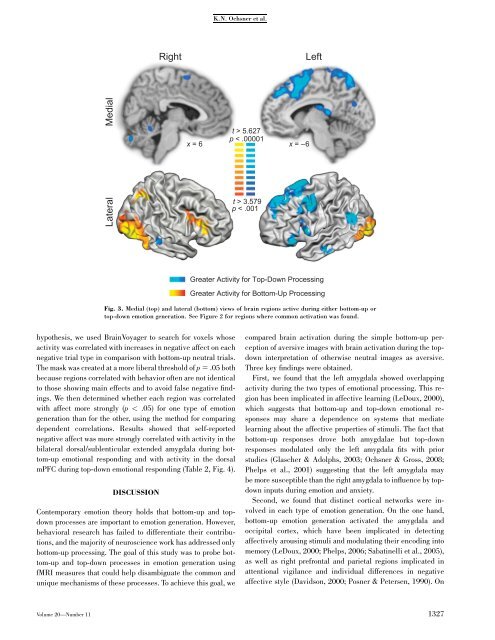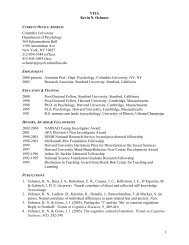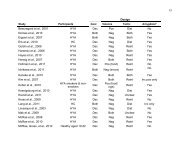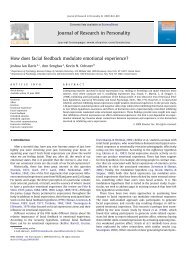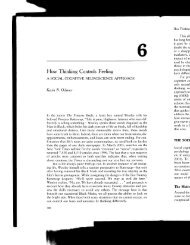Bottom-Up and Top-Down Processes in Emotion Generation
Bottom-Up and Top-Down Processes in Emotion Generation
Bottom-Up and Top-Down Processes in Emotion Generation
Create successful ePaper yourself
Turn your PDF publications into a flip-book with our unique Google optimized e-Paper software.
K.N. Ochsner et al.RightLeftLateral Medialt > 5.627x = 6p < .00001x = –6t > 3.579p < .001Greater Activity for <strong>Top</strong>-<strong>Down</strong> Process<strong>in</strong>gGreater Activity for <strong>Bottom</strong>-<strong>Up</strong> Process<strong>in</strong>gFig. 3. Medial (top) <strong>and</strong> lateral (bottom) views of bra<strong>in</strong> regions active dur<strong>in</strong>g either bottom-up ortop-down emotion generation. See Figure 2 for regions where common activation was found.hypothesis, we used Bra<strong>in</strong>Voyager to search for voxels whoseactivity was correlated with <strong>in</strong>creases <strong>in</strong> negative affect on eachnegative trial type <strong>in</strong> comparison with bottom-up neutral trials.The mask was created at a more liberal threshold of p 5 .05 bothbecause regions correlated with behavior often are not identicalto those show<strong>in</strong>g ma<strong>in</strong> effects <strong>and</strong> to avoid false negative f<strong>in</strong>d<strong>in</strong>gs.We then determ<strong>in</strong>ed whether each region was correlatedwith affect more strongly (p < .05) for one type of emotiongeneration than for the other, us<strong>in</strong>g the method for compar<strong>in</strong>gdependent correlations. Results showed that self-reportednegative affect was more strongly correlated with activity <strong>in</strong> thebilateral dorsal/sublenticular extended amygdala dur<strong>in</strong>g bottom-upemotional respond<strong>in</strong>g <strong>and</strong> with activity <strong>in</strong> the dorsalmPFC dur<strong>in</strong>g top-down emotional respond<strong>in</strong>g (Table 2, Fig. 4).DISCUSSIONContemporary emotion theory holds that bottom-up <strong>and</strong> topdownprocesses are important to emotion generation. However,behavioral research has failed to differentiate their contributions,<strong>and</strong> the majority of neuroscience work has addressed onlybottom-up process<strong>in</strong>g. The goal of this study was to probe bottom-up<strong>and</strong> top-down processes <strong>in</strong> emotion generation us<strong>in</strong>gfMRI measures that could help disambiguate the common <strong>and</strong>unique mechanisms of these processes. To achieve this goal, wecompared bra<strong>in</strong> activation dur<strong>in</strong>g the simple bottom-up perceptionof aversive images with bra<strong>in</strong> activation dur<strong>in</strong>g the topdown<strong>in</strong>terpretation of otherwise neutral images as aversive.Three key f<strong>in</strong>d<strong>in</strong>gs were obta<strong>in</strong>ed.First, we found that the left amygdala showed overlapp<strong>in</strong>gactivity dur<strong>in</strong>g the two types of emotional process<strong>in</strong>g. This regionhas been implicated <strong>in</strong> affective learn<strong>in</strong>g (LeDoux, 2000),which suggests that bottom-up <strong>and</strong> top-down emotional responsesmay share a dependence on systems that mediatelearn<strong>in</strong>g about the affective properties of stimuli. The fact thatbottom-up responses drove both amygdalae but top-downresponses modulated only the left amygdala fits with priorstudies (Glascher & Adolphs, 2003; Ochsner & Gross, 2008;Phelps et al., 2001) suggest<strong>in</strong>g that the left amygdala maybe more susceptible than the right amygdala to <strong>in</strong>fluence by topdown<strong>in</strong>puts dur<strong>in</strong>g emotion <strong>and</strong> anxiety.Second, we found that dist<strong>in</strong>ct cortical networks were <strong>in</strong>volved<strong>in</strong> each type of emotion generation. On the one h<strong>and</strong>,bottom-up emotion generation activated the amygdala <strong>and</strong>occipital cortex, which have been implicated <strong>in</strong> detect<strong>in</strong>gaffectively arous<strong>in</strong>g stimuli <strong>and</strong> modulat<strong>in</strong>g their encod<strong>in</strong>g <strong>in</strong>tomemory (LeDoux, 2000; Phelps, 2006; Sabat<strong>in</strong>elli et al., 2005),as well as right prefrontal <strong>and</strong> parietal regions implicated <strong>in</strong>attentional vigilance <strong>and</strong> <strong>in</strong>dividual differences <strong>in</strong> negativeaffective style (Davidson, 2000; Posner & Petersen, 1990). OnVolume 20—Number 11 1327


